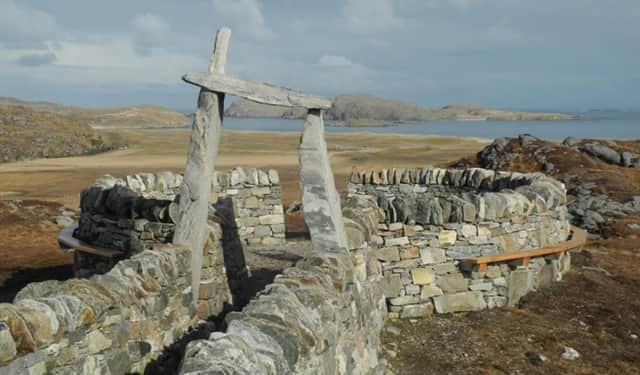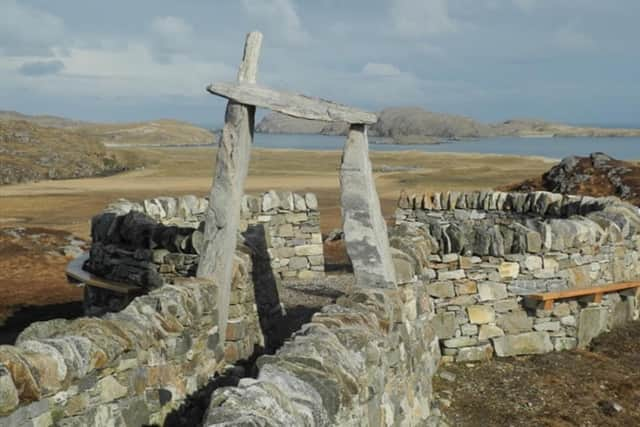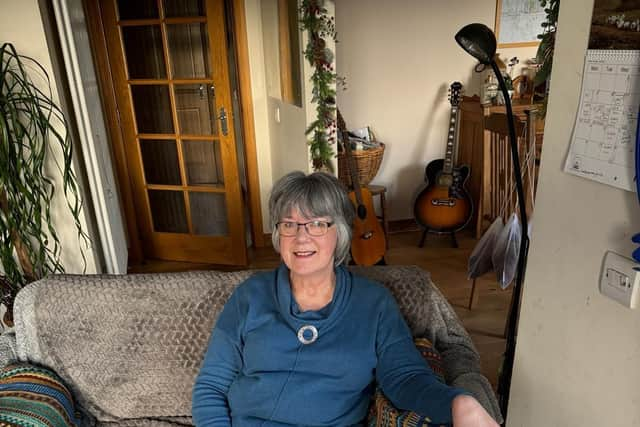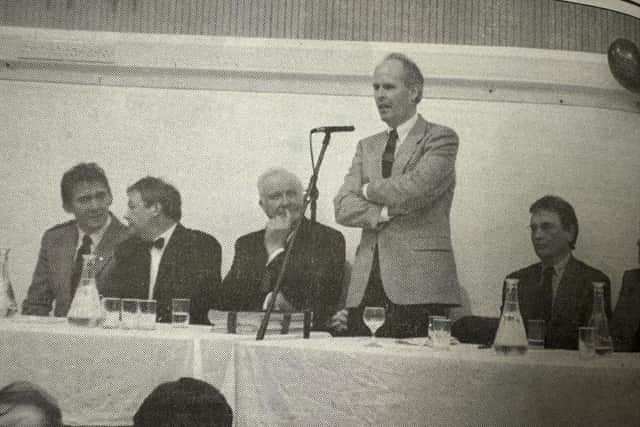History and a willing seller paved the way to first isles buy-out


Instead, most buy-outs depended on having a willing seller and a bit of luck. Both elements were essential to the first community buy-out in the Western Isles, the 25th anniversary of which will be celebrated in Uig next week.
The Bhaltos Estate buy-out was relatively small but it was highly significant nevertheless. Not only did it bring 1700 acres of Uig under the ownership and management of the people who live there and re-paid a debt to past generations, it also set a precedent at a crucial point when others were in need of inspiration.
Advertisement
Hide AdAdvertisement
Hide AdThe back story to the Valtos buy-out could hardly have been more random. The critical starting point was that, at some point, the Valtos peninsula had the historic good fortune to be separated from the rest of Uig estate. Otherwise it would still be part of a private empire.


Until the mid-1980s, the Valtos crofting estate was owned by the Robertson family, who were well-regarded and still have a house in the village. When they put it on the market, an unlikely buyer emerged, already called … Valtos Ltd.
In the 1970s, two Glasgow architects, John Beveridge and James Gilchrist, formed a partnership and needed a name for it. James recalled this week: “Beveridge & Gilchrist didn’t trip off the tongue so John, who had been on holiday in Valtos, suggested: ‘Why not do something different and call it Valtos Ltd?’.
“A few years later, a surveyor pal noticed that an estate called Valtos was being sold by auction in London. I took a look and it seemed a good idea – I liked the name, good beach, and it was close to where the Lewis chessmen came from”. They succeeded in buying it for “sixty or seventy thousand quid”.
Advertisement
Hide AdAdvertisement
Hide AdSo a holiday in Valtos led to a company being formed called Valtos and the company called Valtos led to the otherwise entirely unrelated purchase of Valtos Estate. You don’t get much more random than that! But it proved serendipitous.


The price reflected the fact that, in these days, there was no profit in crofting estates.
So long as crofting regulation was enforced, the landlord’s role was kept at bay which suited James Gilchrist fine. The crofting administration side was left to lawyers in Stornoway and the landlords were benignly absent.
Their architectural firm flourished and opened an office in Oman, to service the region.
Advertisement
Hide AdAdvertisement
Hide AdIn 1998, I was UK Trade Minister, leading a mission to Dubai. I couldn’t help noticing that one of the businesses was called Valtos Ltd, represented by a James Gilchrist. Our first conversation quickly moved from architectural opportunities in the Gulf to a crofting estate in Lewis.


By then, John Beveridge was in poor health and James Gilchrist was ready to sell the Valtos estate. There had been a lot of publicity about community ownership and he was wide open to the option, as I reported back.
At the other end, there was enthusiastic support, particularly from Norman ‘Dokus’ Macdonald and the late Sandy Mackenzie, who became chairman of a steering group, with invaluable legal advice from Simon Fraser.
Within a few months, the funding package of £110,000 was put together with contributions from the Scottish Office, HIE, Scottish Natural Heritage and the Crofters Commission with Comhairle nan Eilean Siar providing the last brick in the wall after Gilchrist himself “donated’ £15,000 by cutting the agreed price.
Advertisement
Hide AdAdvertisement
Hide AdNow retired in the south of England, he recalled with affection the historic event in Uig Community Centre on February 26th 1999 at which the buy-out was formalised.
“It was a fantastic occasion ," he said. “ I was presented with a beautiful chessboard which I’ve still got; it was quite special. It was a good way of exiting and ownership went to the right people”.
It was an evening of emotion and speeches. The shortest one came from James Gilchrist: “It’s up to you now to make a success of it and to make us proud of your achievements”. Sandy Mackenzie thanked him ‘for giving us the opportunity to buy the estate” and the funding agencies for the way they “all worked together”. Changed days indeed!
Sandy ”also referred movingly to the only sadness of the evening – the recent death of John Angus Mackay, one of the leading figures in the local community, a strong supporter of the buy-out and son of one of the Riof Raiders”. It was an evening on which the future was inextricably linked to the past.
Advertisement
Hide AdAdvertisement
Hide AdThe chairman of the Crofters Commission, Iain Macaskill, declared: “The future of crofting communities lies in running their own affairs. People must have the opportunity of staying here and the young must have the opportunity of working here”.
It is difficult to imagine the chairman of a present day quango making any such statement, least of all the Crofting Commission.
Calum George Buchanan was on the first board of the Bhaltos Trust. He recalls: “It was a very exciting time. Not only did the community own the land but there was money to do things in co-operation with the crofting villages that had been needed for years”.
From the outset, the board consisted of two members from each of the five villages on the estate, one representing the crofting interest – Bhaltos, Riof, Cnip, Uigean and Clibhe.
Advertisement
Hide AdAdvertisement
Hide AdFor the most part, the priority of the past 25 years has been to manage of the crofting estate sympathetically, which involves considerable administrative work for a volunteer committee. Unlike the bigger buy-outs, the Bhaltos Trust has never been in a position to employ staff.
There have been lots of quiet good works but the biggest project undertaken was a bold one which confirmed how much the buy-out symbolised in terms of history, as well as practical value.
This was An Sùileachan – a stunning memorial to honour the past generations who resisted the absolute power of landlordism and restored land to the crofting population of the peninsula. The populations of Riof, Bhaltos and Cnip were evicted by Sir James Matheson in 1850-51 with those who remained crowded into two villages.
At this time, 40,000 acres of Uig were taken out of crofting use and given over to sheep-farms and sporting estates by Matheson. In the peninsula, those who remained continued to resist. In 1914, 18 men who raided Riof were taken to Edinburgh and imprisoned by the Court of Session. It was not until 1921 that the Bhaltos peninsula was restored to crofting use.
Advertisement
Hide AdAdvertisement
Hide AdWith that history, it was hardly surprising the buy-out of Bhaltos was seen as a noble reversal of history with some descendants of imprisoned raiders still in their home villages. Without that struggle, there would have been no people. An Sùileachan was designed by Will Maclean and Marion Leven, to commemorate all that, as well as looking towards the future.
Donella Macdonald, current chair of the Bhaltos Trust, describes An Sùileachan as “a very visible project which was important for the heritage and culture of the community”.
They have not since had resources to do anything on a comparable scale but the landmark anniversary is an opportunity to celebrate what exists and look towards the future.
In the early stages, there were hopes the old Valtos School could be turned into an outdoor centre but after an immense amount of work, funding never materialised and the building was eventually demolished; an asset lost in a fantastic location. The Bhaltos Trust now owns the bare site and has plans for limited uses to benefit locals and visitors.
Advertisement
Hide AdAdvertisement
Hide AdThe records of the crofting estate have been computerised and this should free up time and energy to look at more projects. Because of the Trust estate’s size, Donella acknowledges, everything has to be done through partnerships. “There are plenty ideas”, she says. “Crofting is healthy and diversifying. We have young families and an evolving community where the people who come in are generous with their skill-sets”.
Housing is an obvious priority, in an area of high scenic value and inflated prices. Donella says: “In a community like this, we lack affordable housing. Not everyone who wants to live here wants the responsibility of a croft. We have youngsters who would love to be here. Potentially, there is land that could be released – but it would be a huge project for the Trust to be involved in”.
Having been the original Western Isles buy-out, the Bhaltos Trust now looks to its bigger brethren which followed, like Galson and North Harris, for advice and support.
For example, that kicked in very effectively, says Donella, when “far more deer than there used to be” were coming into the villages. The experience of others was essential in dealing with the kind of problem a community-owned estate feels obliged to address.
Advertisement
Hide AdAdvertisement
Hide AdWhile the Bhaltos Trust covers only one corner of Uig, never mind the whole Western Isles, there is no doubt that the willingness 25 years ago to take on the challenge of ownership influenced others and helped create a domino effect. But without legislation, the process would soon run out of dominoes.
Looking back to my own remarks that night, I was hopelessly over-optimistic: “What is being achieved in Bhaltos will soon be available as of right to every crofting community in the Highlands and Islands”. It never happened and community ownership still depends on the kind of luck that linked James Gilchrist to the name, Valtos.
The 25th anniversary ceilidh in the Community Centre will celebrate that outcome.
As Norman Macdonald says: “The place is changing all the time. It’s important to remind people how these things happened – and why it matters”.